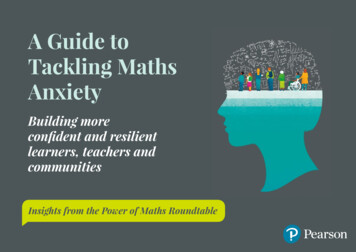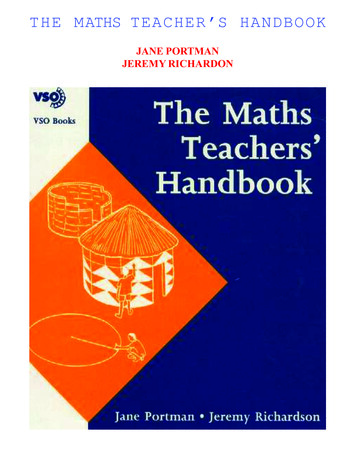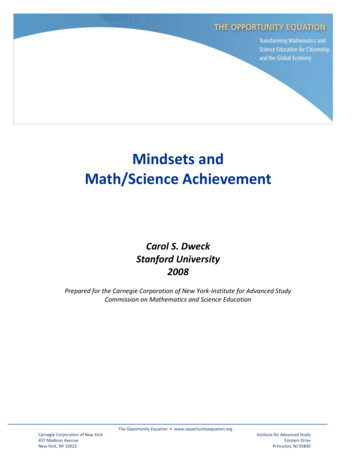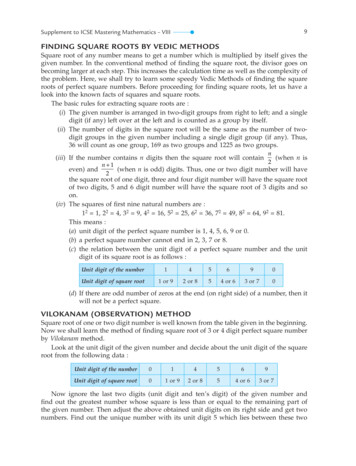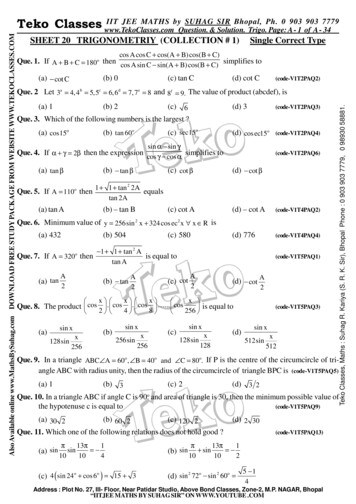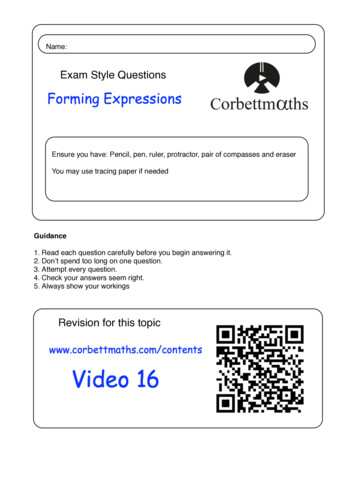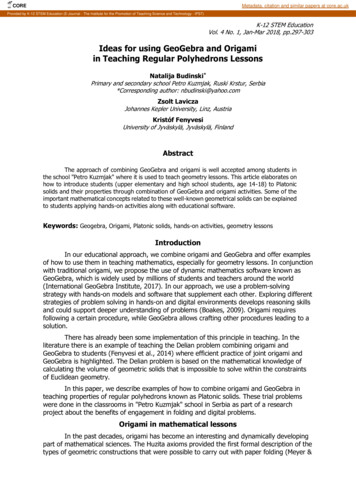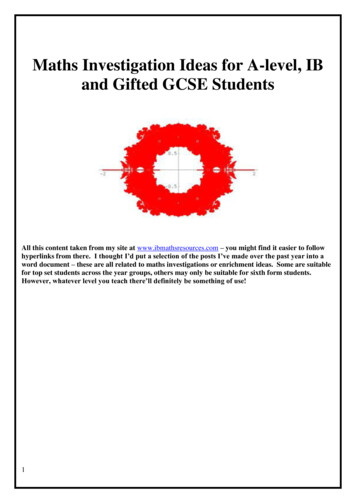
Transcription
Maths Investigation Ideas for A-level, IBand Gifted GCSE StudentsAll this content taken from my site at www.ibmathsresources.com – you might find it easier to followhyperlinks from there. I thought I’d put a selection of the posts I’ve made over the past year into aword document – these are all related to maths investigations or enrichment ideas. Some are suitablefor top set students across the year groups, others may only be suitable for sixth form students.However, whatever level you teach there’ll definitely be something of use!1
Index:Page 3 - 7 More than 100 ideas for investigation/enrichment topics for sixth form maths studentsPages 8 – 10 Secondary data resources and suggestions for investigations ideas.Pages 11 - 22 Statistics TopicsPremier League Finances,The Mathematics of Bluffing,Does Sacking a Manager Affect Results,Maths in Court,Digit Ratios and Maths Ability,The Birthday ProblemPages 23 - 40 Geometry TopicsCircular inversion,Graphically Understanding Complex Roots,Visualising Algebra,The Riemann Sphere,Imagining the 4th DimensionPages 41 – 49 Modelling TopicsModelling Infections,Real Life Differential Equations,Black Swan EventsPages 50 – 71 Pure Maths and CalculusFermat’s Theorem on Squares,Euler and e,Divisibility Tests,Chinese Remainder Theorem,Proof and Paradox,War Maths,The Goldbach Conjecture,The Riemann Hypothesis,Twin Primes,Time TravelPages 72-93 – Games and CodesTic Tac ToeGame Theory and EvolutionKnight’s TourMaths and MusicSynathesiaBenford’s Law to catch fraudstersThe Game of LifeRSA code and the internet,NASA and codes to the stars2
Maths Exploration Topics: 100 ideas for investigations.Algebra and number1) Modular arithmetic - This technique is used throughout Number Theory. For example, Mod 3 means theremainder when dividing by 3.2) Goldbach’s conjecture: "Every even number greater than 2 can be expressed as the sum of twoprimes." One of the great unsolved problems in mathematics.3) Probabilistic number theory4) Applications of complex numbers: The stunning graphics of Mandelbrot and Julia Sets are generated bycomplex numbers.5) Diophantine equations: These are polynomials which have integer solutions. Fermat's Last Theorem isone of the most famous such equations.6) Continued fractions: These are fractions which continue to infinity. The great Indian mathematicianRamanujan discovered some amazing examples of these.7) Patterns in Pascal’s triangle: There are a large number of patterns to discover - including the Fibonaccisequence.8) Finding prime numbers: The search for prime numbers and the twin prime conjecture are some of themost important problems in mathematics. There is a 1 million prize for solving the Riemann Hypothesisand 250,000 available for anyone who discovers a new, really big prime number.9) Random numbers10) Pythagorean triples: A great introduction into number theory - investigating the solutions of Pythagoras'Theorem which are integers (eg. 3,4,5 triangle).11) Mersenne primes: These are primes that can be written as 2 n -1.12) Magic squares and cubes: Investigate magic tricks that use mathematics. Why do magic squares work?13) Loci and complex numbers14) Egyptian fractions: Egyptian fractions can only have a numerator of 1 - which leads to some interestingpatterns. 2/3 could be written as 1/6 1/2. Can all fractions with a numerator of 2 be written as 2 Egyptianfractions?15) Complex numbers and transformations16) Euler’s identity: An equation that has been voted the most beautiful equation of all time, Euler's identitylinks together 5 of the most important numbers in mathematics.17) Chinese remainder theorem. This is a puzzle that was posed over 1500 years ago by a Chinesemathematician. It involves understanding the modulo operation.18) Fermat’s last theorem: A problem that puzzled mathematicians for centuries - and one that has onlyrecently been solved.19) Natural logarithms of complex numbers20) Twin primes problem: The question as to whether there are patterns in the primes has fascinatedmathematicians for centuries. The twin prime conjecture states that there are infinitely many consecutiveprimes ( eg. 5 and 7 are consecutive primes). There has been a recent breakthrough in this problem.21) Hypercomplex numbers3
22) Diophantine application: Cole numbers23) Odd perfect numbers: Perfect numbers are the sum of their factors (apart from the last factor). ie 6 is aperfect number because 1 2 3 6.24) Euclidean algorithm for GCF25) Palindrome numbers: Palindrome numbers are the same backwards as forwards.26) Fermat’s little theorem: If p is a prime number then a p - a is a multiple of p.27) Prime number sieves28) Recurrence expressions for phi (golden ratio): Phi appears with remarkable consistency in nature andappears to shape our understanding of beauty and symmetry.29) The Riemann Hypothesis - one of the greatest unsolved problems in mathematics - worth 1million toanyone who solves it (not for the faint hearted!)30) Time travel to the future: Investigate how traveling close to the speed of light allows people to travel"forward" in time relative to someone on Earth. Why does the twin paradox work?31) Graham's Number - a number so big that thinking about it could literally collapse your brain into a blackhole.32) RSA code - the most important code in the world? How all our digital communications are kept safethrough the properties of primes.33) The Chinese Remainder Theorem: This is a method developed by a Chinese mathematician Sun Zi over1500 years ago to solve a numerical puzzle. An interesting insight into the mathematical field of NumberTheory.34) Cesaro Summation: Does 1 – 1 1 – 1 1/2?. A post which looks at the maths behind thisparticularly troublesome series.35) Fermat's Theorem on the sum of 2 squares - An example of how to use mathematical proof to solveproblems in number theory.36) Can we prove that 1 2 3 4 . -1/12 ? How strange things happen when we start to manipulatedivergent series.37) Mathematical proof and paradox - a good opportunity to explore some methods of proof and to showhow logical errors occur.Geometry1) Non-Euclidean geometries: This allows us to "break" the rules of conventional geometry - for example,angles in a triangle no longer add up to 180 degrees.2) Hexaflexagons: These are origami style shapes that through folding can reveal extra faces.3) Minimal surfaces and soap bubbles: Soap bubbles assume the minimum possible surface area to contain agiven volume.4) Tesseract – a 4D cube: How we can use maths to imagine higher dimensions.5) Stacking cannon balls: An investigation into the patterns formed from stacking canon balls in differentways.6) Mandelbrot set and fractal shapes: Explore the world of infinitely generated pictures and fractionaldimensions.7) Sierpinksi triangle: a fractal design that continues forever.8) Squaring the circle: This is a puzzle from ancient times - which was to find out whether a square could becreated that had the same area as a given circle. It is now used as a saying to represent somethingimpossible.9) Polyominoes: These are shapes made from squares. The challenge is to see how many different shapescan be made with a given number of squares - and how can they fit together?10) Tangrams: Investigate how many different ways different size shapes can be fitted together.11) Understanding the fourth dimension: How we can use mathematics to imagine (and test for) extradimensions.12) The Riemann Sphere - an exploration of some non-Euclidean geometry. Straight lines are not straight,parallel lines meet and angles in a triangle don't add up to 180 degrees.4
Calculus/analysis and functions1) The harmonic series: Investigate the relationship between fractions and music, or investigate whether thisseries converges.2) Torus – solid of revolution: A torus is a donut shape which introduces some interesting topological ideas.3) Projectile motion: Studying the motion of projectiles like cannon balls is an essential part of themathematics of war. You can also model everything from Angry Birds to stunt bike jumping. A good useof your calculus skills.4) Why e is base of natural logarithm function: A chance to investigate the amazing number e.Statistics and modelling1) Traffic flow: How maths can model traffic on the roads.2) Logistic function and constrained growth3) Benford's Law - using statistics to catch criminals by making use of a surprising distribution.4) Bad maths in court - how a misuse of statistics in the courtroom can lead to devastating miscarriages ofjustice.5) The mathematics of cons - how con artists use pyramid schemes to get rich quick.6) Impact Earth - what would happen if an asteroid or meteorite hit the Earth?7) Black Swan events - how usefully can mathematics predict small probability high impact events?8) Modelling happiness - how understanding utility value can make you happier.9) Does finger length predict mathematical ability? Investigate the surprising correlation between fingerratios and all sorts of abilities and traits.10) Modelling epidemics/spread of a virus11) The Monty Hall problem - this video will show why statistics often lead you to unintuitive results.12) Monte Carlo simulations13) Lotteries14) Bayes’ theorem: How understanding probability is essential to our legal system.15) Birthday paradox: The birthday paradox shows how intuitive ideas on probability can often bewrong. How many people need to be in a room for it to be at least 50% likely that two people will share thesame birthday? Find out!16) Are we living in a computer simulation? Look at the Bayesian logic behind the argument that we areliving in a computer simulation.17) Does sacking a football manager affect results? A chance to look at some statistics with surprisingresults.18) Which times tables do students find most difficult? A good example of how to conduct a statisticalinvestigation in mathematics.Games and game theory1) The prisoner’s dilemma: The use of game theory in psychology and economics.2) Sudoku3) Gambler’s fallacy: A good chance to investigate misconceptions in probability and probabilities ingambling. Why does the house always win?4) Bluffing in Poker: How probability and game theory can be used to explore the the best strategies forbluffing in poker.5) Knight’s tour in chess: This chess puzzle asks how many moves a knight must make to visit all squares ona chess board.6) Billiards and snooker7) Zero sum games8) How to "Solve" Noughts and Crossess (Tic Tac Toe) - using game theory. This topics provides afascinating introduction to both combinatorial Game Theory and Group Theory.5
9) Maths and football - Do managerial sackings really lead to an improvement in results? We can analysethe data to find out. Also look at the finances behind Premier league teamsTopology and networks1) Knots2) Steiner problem3) Chinese postman problem4) Travelling salesman problem5) Königsberg bridge problem: The use of networks to solve problems. This particular problem was solvedby Euler.6) Handshake problem: With n people in a room, how many handshakes are required so that everyoneshakes hands with everyone else?7) Möbius strip: An amazing shape which is a loop with only 1 side and 1 edge.8) Klein bottle9) Logic and sets10) Codes and ciphers: ISBN codes and credit card codes are just some examples of how codes are essentialto modern life. Maths can be used to both make these codes and break them.11) Zeno’s paradox of Achilles and the tortoise: How can a running Achilles ever catch the tortoise if in thetime taken to halve the distance, the tortoise has moved yet further away?12) Four colour map theorem - a puzzle that requires that a map can be coloured in so that everyneighbouring country is in a different colour. What is the minimum number of colours needed for any map?Further ideas:1) Radiocarbon dating - understanding radioactive decay allows scientists and historians to accurately workout something's age - whether it be from thousands or even millions of years ago.2) Gravity, orbits and escape velocity - Escape velocity is the speed required to break free from a body'sgravitational pull. Essential knowledge for future astronauts.3) Mathematical methods in economics - maths is essential in both business and economics - explore someeconomics based maths problems.4) Genetics - Look at the mathematics behind genetic inheritance and natural selection.5) Elliptical orbits - Planets and comets have elliptical orbits as they are influenced by the gravitational pullof other bodies in space. Investigate some rocket science!6) Logarithmic scales – Decibel, Richter, etc. are examples of log scales - investigate how these scales areused and what they mean.7) Fibonacci sequence and spirals in nature - There are lots of examples of the Fibonacci sequence in reallife - from pine cones to petals to modelling populations and the stock market.8) Change in a person’s BMI over time - There are lots of examples of BMI stats investigations online - seeif you can think of an interesting twist.9) Designing bridges - Mathematics is essential for engineers such as bridge builders - investigate how todesign structures that carry weight without collapse.10) Mathematical card tricks - investigate some maths magic.Voting systems11) Flatland by Edwin Abbott - This famous book helps understand how to imagine extra dimension. Youcan watch a short video on it here12) Towers of Hanoi puzzle - This famous puzzle requires logic and patience. Can you find the patternbehind it?13) Different number systems - Learn how to add, subtract, multiply and divide in Binary. Investigate howbinary is used - link to codes and computing.14) Methods for solving differential equations - Differential equations are amazingly powerful at modellingreal life - from population growth to to pendulum motion. Investigate how to solve them.15) Modelling epidemics/spread of a virus - what is the mathematics behind understanding how epidemics6
occur?16) Hyperbolic functions - These are linked to the normal trigonometric functions but with notabledifferences. They are useful for modelling more complex shapes.7
Statistics and Probability InvestigationsPrimary or Secondary data?The main benefit of primary data is that you can really personalise your investigation. It allows you scope toinvestigate something that perhaps no-one else has ever done. It also allows you the ability to generate datathat you might not be able to find online. The main drawback is that collecting good quality data insufficient quantity to analyze can be time consuming. You should aim for an absolute minimum of 50pieces of data – and ideally 60-100 to give yourself a good amount of data to look at.The benefits of secondary data are that you can gain access to good quality raw data on topics thatyou wouldn’t be able to collect data on personally – and it’s also much quicker to get the data. Potentialdrawbacks are not being able to find the raw data that fits what you want to investigate – or sometimeshaving too much data to wade through.Secondary data sources:1) The Census at School website is a fantastic source of secondary data to use. If you go to the random datagenerator you can download up to 200 questionnaire results from school children around the world on anumber of topics (each year’s questionnaire has up to 20 different questions). Simply fill in your emailaddress and the name of your school and then follow the instructions.2) If you’re interested in sports statistics then the Olympic Database is a great resource. It contains anenormous amount of data on winning times and distances in all events in all Olympics. Follow links at thetop of the page to similar databases on basketball, golf, baseball and American football.3) If you prefer football, the the Guardian stats centre has information on all European leagues – you can seewhen a particular team scores most of their goals, how many goals they score a game, how many red cardsthey average etc. You can also find a lot of football stats on the Who Scored website. This gives you dataon things like individual players’ shots per game, pass completion rate etc.4) The Guardian Datablog has over 800 data files to view or download – everything from the PremierLeague football accounts of clubs to a list of every Dr Who villain, US gun crime, UK unemploymentfigures, UK GCSE results by gender, average pocket money and most popular baby names. You will needto sign into Google to download the files.5) The World Bank has a huge data bank - which you can search by country or by specific topic. You cancompare life-expectancy rates, GDP, access to secondary education, spending on military, social inequality,how many cars per 1000 people and much much more.6) Gapminder is another great resource for comparing development indicators – you can plot 2 variables ona graph (for example urbanisation against unemployment, or murder rates against urbanisation) and then runthem over a number of years. You can also download Excel speadsheets of the associated data.7) Wolfram Alpha is one of the most powerful maths and statistics tools available – it has a staggeringamount of information that you can use. If you go to the examples link above, then you can choose fromdata on everything from astronomy, the human body, geography, food nutrition, sports, socioeconomics,education and shopping.Example Maths Studies IA Investigations:Some of these ideas taken from the excellent Oxford IB Maths Studies textbook.8
Correlations:1) Is there a correlation between hours of sleep and exam grades?Studies have shown that a good night’s sleep raises academic attainment.2) Is there a correlation between height and weight?The NHS use a chart to decide what someone should weigh depending on their height. Does this mean thatheight is a good indicator of weight?3) Is there a correlation between arm span and foot height?This is also a potential opportunity to discuss the Golden Ratio in nature.4) Is there a correlation between the digit ratio and maths ability?Studies show there is a correlation between digit ratio and everything from academic ability, aggression andeven sexuality.5) Is there a correlation between smoking and lung capacity?6) Is there a correlation between GDP and life expectancy?Run the Gapminder graph to show the changing relationship between GDP and life expectancy over the pastfew decades.7) Is there a correlation between numbers of yellow cards a game and league position?Use the Guardian Stats data to find out if teams which commit the most fouls also do the best in the league.8) Is there a correlation between Olympic 100m sprint times and Olympic 15000m times?Use the Olympic database to find out if the 1500m times have go faster in the same way the 100m timeshave got quicker over the past few decades.9) Is there a correlation between sacking a football manager and improved results?A recent study suggests that sacking a manager has no benefit and the perceived improvement in results isjust regression to the mean.10) Is there a correlation between time taken getting to school and the distance a student lives from school?11) Does eating breakfast affect your grades?12) Is there a correlation between stock prices of different companies?Use Google Finance to collect data on company share prices.13) Does teenage drinking affect grades?A recent study suggests that higher alcohol consumption amongst teenagers leads to greater social stress andpoorer grades.14) Is there a correlation between unemployment rates and crime?If there are less work opportunities, do more people turn to crime?15) Is there a correlation between female participation in politics and wider access to further education?16) Is there a correlation between blood alcohol laws and traffic accidents?17) Is there a correlation between height and basketball ability?18) Is there a correlation between stress and blood pressure?Normal distributions:1) Are a sample of student heights normally distributed?We know that adult population heights are normally distributed – what about student heights?2) Are a sample of flower heights normally distributed?3) Are a sample of student weights normally distributed?4) Are a sample of student reaction times normally distributed?Conduct this BBC reaction time test to find out.5) Are a sample of student digit ratios normally distributed?6) Are the IB maths test scores normally distributed?IB test scores are designed to fit a bell curve. Investigate how the scores from different IB subjects compare.7) Are the weights of “1kg” bags of sugar normally distributed?Other statistical investigations9
1) Does gender affect hours playing sport?A UK study showed that primary school girls play much less sport than boys.2) Investigation into the distribution of word lengths in different languages.The English language has an average word length of 5.1 words. How does that compare with otherlanguages?3) Do bilingual students have a greater memory recall than non-bilingual students?Studies have shown that bilingual students have better “working memory” – does this include memoryrecall?4) Investigation about the distribution of sweets in packets of Smarties. A chance to buy lots ofsweets! Also you could link this with some optimisation investigation.Probability and statistics1) The probability behind poker games2) Finding expected values for games of chance in a casino.3) Birthday paradox:The birthday paradox shows how intuitive ideas on probability can often be wrong. How many people needto be in a room for it to be at least 50% likely that two people will share the same birthday? Find out!4) Which times tables do students find most difficult?A good example of how to conduct a statistical investigation in mathematics.5) Handshake problemWith n people in a room, how many handshakes are required so that everyone shakes hands with everyoneelse?10
Statistics TopicsIs there a correlation between Premier League wages and league position?The Guardian has just released its 2012-13 Premier League season data analysis - which shows exactly howmuch each club in the Premier League spent on wages last year (see the bar chart above). This can be easilyplotted on a scatter graph to test how strong the correlation is between spending and league position. (y axisis league position, x axis is wage bill in millions of pounds).The mean spending on wages is 89 million pounds. Our regression line is y -0.08x 17.52. We can seesome of the big outliers are QPR (with a big wage bill but low premier league position) and Everton (with alow wage bill relative to others who finished in a similar position).The Pearson's product moment correlation coefficient (r) is -0.73. This is negative because in our caseleague position is numerically lower the higher up the league you are. This shows a pretty strong correlationbetween league spending and league position. An r value of -1 would be a perfect correlation in our case,whereas 0 would be no correlation.11
Is there a correlation between turnover and league position?We can also see what the correlation is between league position and overall club turnover (see the bar chartabove). Here we can see there is a huge gulf between the top few clubs and everyone else in theleague. There's only 40 million pounds difference between the bottom ranked club for revenue Wigan andNewcastle, with the 7th biggest revenue. But then a massive jump up to those with the top 6 revenues.This time we have a mean turnover of 128 million pounds and a regression line of y -0.05x 16.89. ThePearson's r value this time is r -0.79, so there is a slightly stronger correlation than from wages - and this isa strong correlation overall. So, both wage bills and turnover provide a pretty good predictor of where ateam will finish - and also a decent yardstick to measure how well a team has done relative to theirresources.12
The Mathematics of BluffingThis post is based on the fantastic PlusMaths article on bluffing- which is a great introduction to thistopic. If you're interested then it's well worth a read. This topic shows the power of mathematics in solvingreal world problems - and combines a wide variety of ideas and methods - probability, Game Theory,calculus, psychology and graphical analysis.You would probably expect that there is no underlying mathematical strategy for good bluffing in poker indeed that a good bluffing strategy would be completely random so that other players are unable to spotwhen a bluff occurs. However it turns out that this is not the case.As explained by John Billingham in the PlusMaths article, when considering this topic it helps to reallysimplify things first. So rather than a full poker game we instead consider a game with only 2 players andonly 3 cards in the deck (1 Ace, 1 King, 1 Queen).The game then plays as follows:1) Both players pay an initial 1 into the pot.2) The cards are dealt - with each player receiving 1 card.3) Player 1 looks at his card and can:(a) check(b) bet an additional 14) Player 2 then can respond:a) If Player 1 has checked, Player 2 must also check. This means both cards are turned over and the highestcard wins.b) If Player 1 has bet 1 then Player 2 can either match (call) that 1 bet or fold. If the bets are matched thenthe cards are turned over and the highest card wins.So, given this game what should the optimal strategy be for Player 1? An Ace will always win a showdown,and a Queen always lose - but if you have a Queen and bet, then your opponent who may only have a Kingmight decide to fold thinking you actually have an Ace.In fact the optimal strategy makes use of Game Theory - which can mathematically work out exactly howoften you should bluff:13
This tree diagram represents all the possible outcomes of the game. The first branch at the top represents the3 possible cards that Player 2 can be dealt (A,K,Q) each of which have a probability of 1/3. The secondbranch represents the remaining 2 possible cards that Player 1 has - each with probability 1/2. The numbersat the bottom of the branches represent the potential gain or loss from betting strategies for Player 2 - this iscalculated by comparing the profit/loss relative to if both players had simply shown their cards at thebeginning of the game.For example, Player 2 has no way of winning any money with a Queen - and this is represented by the leftbranch 0, 0. Player 2 will always win with an Ace. If Player 1 has a Queen and bluffs then Player 2 willcall the bet and so will have gained an additional 1 of his opponents money relative to a an initial gameshowdown (represented by the red branch). Player 1 will always check with a King (as were he to bet thenPlayer 2 would always call with an Ace and fold with a Queen) and so the AK branch also has a 0 outcomerelative to an initial showdown.So, the only decisions the game boils down to are:1) Should Player 1 bluff with a Queen? (Represented with a probability of b on the tree diagram )2) Should Player 2 call with a King? (Represented with a probability of c on the tree diagram ).Now it's simply a case of adding the separate branches of the tree diagram to find the expected value forPlayer 2.The right hand branch (for AQ and AK) for example gives:1/3 . 1/2 . b . 11/3 . 1/2 . (1-b) . 01/3 . 1/2 . 0So, working out all branches gives:Expected Value for Player 2 0.5b(c-1/3) - c/6Expected Value for Player 1 -0.5b(c-1/3) c/6(Player 1's Expected Value is simply the negative of Player 2's. This is because if Player 2 wins 1 thenPlayer 1 must have lost 1). The question is what value of b (Player 1 bluff) should be chosen by Player 1 tomaximise his earnings? Equally, what is the value of c (Player 2 call) that maximises Player 2's earnings?It is possible to analyse these equations numerically to find the optimal values (this method is explained inthe article), and also to employ both graphical means or calculus to arrive at the optimum strategy of c 1/3and b 1/3.14
Does Sacking a Manager Affect Results?In sports leagues around the world, managers are often only a few bad results away from the sack - but isthis all down to a misunderstanding of statistics?According to the Guardian, in the 21 year history of the Premier League, approximately 140 managers havebeen sacked. In more recent years the job is getting ever more precarious - 12 managers lost their jobs in2013, and 20 managers in the top flight have been shown the door in the last 2 years. Indeed, there are nowonly three Premier League managers who have held their position for more than 2 years (Arsene Wenger,Sam Allardyce and Alan Pardew).Owners appear attracted to the idea that a new manager can bring a sudden improvement in results - andindeed most casual observers of football would agree that new managers often seem to pull out some goodinitial results. But according to Dutch economist Dr Bas ter Weel this is just a case of regression to the mean- if a team has been underperforming relative to their abilities then over the long run we would expect themto improve to get closer to the mean value.As the BBC reported:"Changing a manager during a crisis in the season does improve the results in the short term," Dr Bas terWeel says. "But this is a misleading statistic because not changing the manager would have had the sameresult."Ter Weel analysed managerial turnover across 18 seasons (1986-2004) of the Dutch premier division, theEredivisie. As well as looking at what happened to teams who sacked their manager when the going gottough, he looked at those who had faced a similar slump in form but who stood by their boss to ride out thecrisis.He found that both groups faced a similar pattern of declines and improvements in form.By looking at the graph at the top of the page it is clear to see that sacking a manager may have appeared tolead to an improvement in results - but that actually had the manager not been sacked results wou
32) RSA code - the most important code in the world? How all our digital communications are kept safe through the properties of primes. 33) The Chinese Remainder Theorem : This is a method developed by a Chinese mathematician Sun Zi over 1500 years ago to solve a numerical puzzle. An interest
